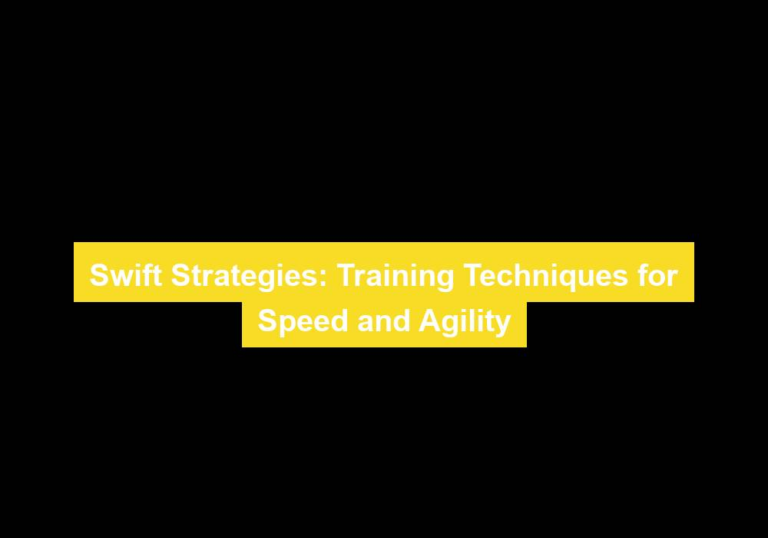Agility Unleashed: Speed Training for Performance Enhancement
Did you know that according to a study published in the Journal of Strength and Conditioning Research, athletes who underwent agility training saw a 28% improvement in their speed and quickness? You might be surprised by the significant impact that agility training can have on overall athletic performance. But itG??s not just about speed – agility also plays a crucial role in enhancing coordination, balance, and reactive abilities. As you explore the world of agility training, youG??ll uncover the key components of speed training, the benefits it offers to athletes, and the specific drills that can take your performance to the next level. Get ready to discover how agility training can unleash your full potential on the field or court.
The Importance of Agility Training
Enhancing agility is crucial for maximizing performance in sports and athletic activities. Agility benefits athletes by improving their ability to change direction quickly, accelerate and decelerate efficiently, and maintain control while moving at high speeds. By incorporating agility techniques into your training regimen, you can significantly enhance your performance on the field or court.
Agility training offers a myriad of benefits that directly translate to improved athletic performance. Firstly, it enhances your bodyG??s coordination, balance, and proprioception, allowing you to move more fluidly and with greater control. This means you can swiftly navigate through obstacles, evade opponents, and react promptly to game-changing situations. Additionally, agility training helps reduce the risk of injuries by strengthening stabilizing muscles, improving joint stability, and enhancing overall body awareness.
To develop and refine your agility, there are several effective techniques that you can incorporate into your workouts. Cone drills, ladder drills, and shuttle runs are excellent for improving footwork, speed, and directional changes. These exercises simulate the movement patterns commonly encountered in sports and help condition your body to respond quickly and efficiently. Furthermore, plyometric exercises like box jumps and lateral bounds can enhance your explosive power and quickness. Incorporating these agility techniques into your training routine will undoubtedly elevate your performance and give you a competitive edge in your athletic endeavors.
Key Components of Speed Training
To optimize your speed training, it is essential to focus on key components that will enhance your overall athletic performance. Two crucial elements of speed training are explosive power and acceleration techniques. Explosive power is the ability to generate force rapidly, essential for quick movements during sprints, jumps, or changes in direction. To develop explosive power, incorporate plyometric exercises such as box jumps, explosive push-ups, and medicine ball throws into your training regimen. These exercises help improve muscle strength, speed, and coordination, leading to enhanced overall speed and agility.
Acceleration techniques are equally vital in speed training. Proper sprinting mechanics are fundamental for maximizing acceleration. Focus on driving your knees up and pumping your arms efficiently, keeping your body in a forward-leaning position to generate maximum speed. Incorporating resistance training, such as sled pulls or hill sprints, can further enhance your acceleration abilities by strengthening the muscles used in explosive forward propulsion.
Incorporating both explosive power and acceleration techniques into your speed training program will result in significant improvements in your athletic performance. Developing explosive power will allow you to generate more force with each stride, while mastering acceleration techniques will enable you to reach your top speed more quickly. By prioritizing these key components, you will unleash your full potential and take your speed and agility to the next level.
Benefits of Agility for Athletes
Agility training offers numerous benefits for athletes. It improves speed and coordination, enabling you to move quickly and efficiently on the field or court. Additionally, it hones your ability to make quick decisions, giving you a competitive edge in fast-paced sports. Moreover, agility exercises help prevent injuries by enhancing your bodyG??s ability to react and adapt to sudden changes in direction.
Speed and Coordination
Developing speed and coordination is essential for athletes looking to enhance their performance on the field or court. Speed directly impacts reaction time, while coordination affects balance and flexibility, both of which are critical for explosiveness. HereG??s a breakdown of how improving speed and coordination can benefit athletes:
| Speed | Coordination |
|---|---|
| – Faster sprint times | – Improved body control |
| – Enhanced agility | – Better hand-eye coordination |
| – Quick directional changes | – Superior proprioception |
| – Increased acceleration | – Enhanced spatial awareness |
| – Improved overall speed | – Better neuromuscular efficiency |
Quick Decision Making
Improving quick decision-making skills through agility training can significantly enhance an athleteG??s on-field performance. Agility training not only focuses on physical speed and coordination but also sharpens cognitive processing and reaction time. Athletes who undergo agility training develop the ability to make split-second decisions, honing their quick reflexes and enhancing their overall performance. By simulating real-game scenarios and incorporating elements of unpredictability, agility training forces athletes to react swiftly and make quick decisions, mirroring the challenges they face during competitive play. This type of training not only improves physical capabilities but also builds mental resilience and acuity. The combination of physical and mental preparedness gained through agility training empowers athletes to navigate high-pressure situations with confidence, ultimately elevating their on-field performance.
Injury Prevention
To enhance athletic performance and reduce the risk of injury, incorporating agility training into your regimen can significantly benefit athletes. Preventing injuries is crucial for athletes aiming to maintain peak performance. Agility techniques not only improve speed and coordination but also play a vital role in injury prevention. By enhancing stability, balance, and body control, agility training helps athletes avoid common sports-related injuries such as sprains, strains, and ligament tears. HereG??s a practical table highlighting some agility techniques that aid in injury prevention:
| Agility Technique | Description |
|---|---|
| Lateral Plyometric Jumps | Improve lateral strength and stability. |
| Agility Ladder Drills | Enhance footwork, speed, and coordination. |
| Cutting and Change of Direction Drills | Strengthen muscles for quick changes in direction. |
Incorporating these agility techniques into your training routine can significantly reduce the risk of injuries, allowing you to perform at your best.
Agility Drills for Enhanced Performance
To enhance your performance, agility drills focus on developing speed and precision, as well as improving your footwork and control. These drills are essential for athletes looking to improve their ability to change direction quickly and maintain balance during high-intensity movements. By incorporating agility drills into your training regimen, you can expect to see tangible improvements in your overall athletic performance.
Speed and Precision
Enhance your performance with agility drills designed to improve speed and precision. When it comes to agility training, focusing on speed and precision is crucial for maximizing athletic performance. Incorporating drills that challenge your reaction time and explosiveness can significantly enhance your overall agility and coordination. To achieve optimal results, consider adding the following drills to your training routine:
- Ladder Drills: Utilize agility ladders to perform quick and precise footwork patterns, enhancing both speed and precision.
- Cone Drills: Set up a series of cones to practice sharp and agile directional changes, improving your ability to move with precision at high speeds.
- Reaction Ball Exercises: Use a reaction ball to improve hand-eye coordination and reaction time, essential for maintaining precision during high-speed movements.
Integrating these agility drills into your training regimen can lead to noticeable improvements in speed and precision, ultimately elevating your athletic performance.
Footwork and Control
Improving your footwork and control through targeted agility drills can significantly enhance your overall athletic performance. To enhance your agility, focus on drills that emphasize balance and stability, as well as quick direction changes. These drills can help you develop the coordination and control needed to navigate the demands of your sport with precision. Start with exercises that challenge your ability to maintain balance while making sharp turns or sudden stops. Incorporate drills that require quick and controlled footwork, such as ladder drills or cone drills. By consistently practicing these agility drills, you can improve your ability to swiftly change direction without sacrificing stability or control. Mastering footwork and control through targeted drills will undoubtedly elevate your overall athletic performance.
Integrating Agility Into Training Programs
Consider incorporating agility training into your program to enhance overall athletic performance and responsiveness. Integrating agility techniques into your training regimen can significantly improve your sports performance, speed development, and athletic conditioning. HereG??s how you can seamlessly integrate agility training into your program:
-
Dynamic Warm-Up: Begin your training session with a dynamic warm-up that includes agility drills such as ladder exercises, cone drills, and quick feet movements. This will prepare your body for the specific demands of agility training, priming your muscles and nervous system for optimal performance.
-
Integrate Into Workouts: Incorporate agility drills into your regular workouts to improve your speed, coordination, and reaction time. This could involve including ladder drills between strength exercises or incorporating agility cones into your cardio routine, adding an element of unpredictability to your training.
-
Progressive Overload: Gradually increase the intensity and complexity of your agility training over time. Start with basic drills and then progress to more challenging movements as your skills improve. This progressive overload will continuously challenge your body and stimulate adaptations, leading to enhanced agility and performance.
Maximizing Speed and Quickness
To maximize your speed and quickness, focus on incorporating explosive movements and sprint training into your workout regimen. Acceleration techniques play a crucial role in enhancing your speed. To improve your acceleration, focus on driving your knees up and pumping your arms forcefully. Additionally, practicing sprint mechanics such as maintaining a forward lean, driving your elbows back, and landing on the balls of your feet can significantly improve your speed and quickness.
Reaction time is another essential aspect of maximizing your speed and quickness. Incorporating reaction drills into your training, such as agility ladder drills or reactive sprint drills, can help you develop faster reflexes, leading to improved quickness on the field or court. These drills can also enhance your explosive power, allowing you to generate more force with each stride and ultimately increasing your overall speed.
Incorporating explosive power exercises into your training routine is key to maximizing your speed and quickness. Plyometric exercises like box jumps, bounding, and medicine ball throws can help improve your muscle power and explosiveness, leading to faster sprint times and improved agility.
Conclusion
Now that you have learned about the key components of speed training and the benefits of agility for athletes, itG??s time to put your knowledge into action. By integrating agility drills into your training program and maximizing your speed and quickness, you can unleash your full potential and take your performance to the next level. Get ready to see the results of your hard work and dedication on the field or court. Keep pushing yourself, and the rewards will follow.







